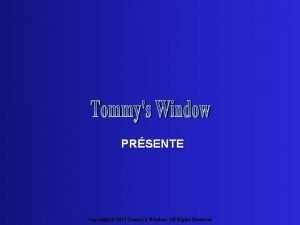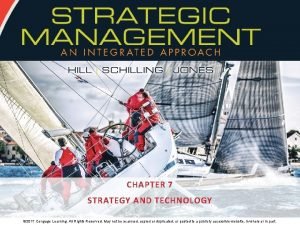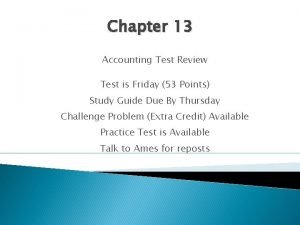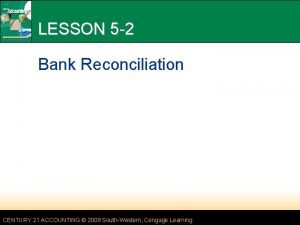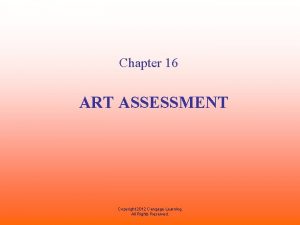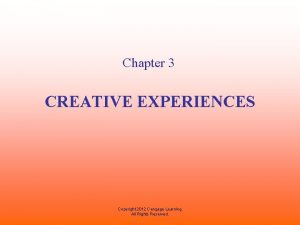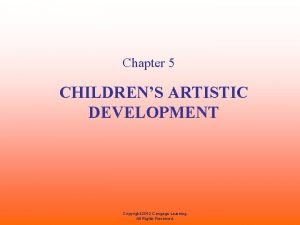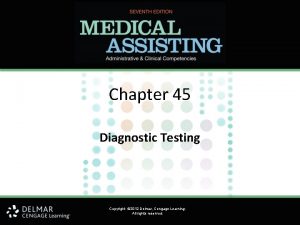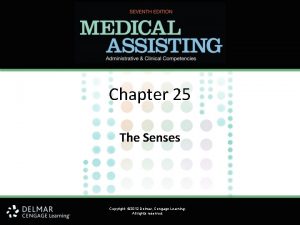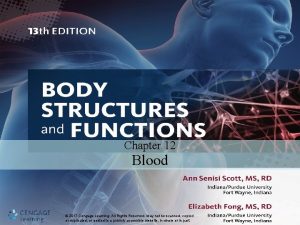Chapter 13 THE ART CENTER Copyright 2012 Cengage



















- Slides: 19

Chapter 13 THE ART CENTER Copyright 2012 Cengage Learning. All Rights Reserved.

Objectives • After reading this chapter, you should be able to: – List and discuss the five criteria for setting up an early childhood art center. – Compare and contrast two- and three-dimensional art media. – Describe ways to make the art center accessible to all children in the classroom. – Identify potential rules and limits for successfully operating an early childhood art center. – Evaluate the effectiveness of an art center/program. – Make puppets and masks. Copyright 2012 Cengage Learning. All Rights Reserved.

The Art Center • The classroom art center is an area where children can go to engage in art. Copyright 2012 Cengage Learning. All Rights Reserved.

The Art Center (continued) • The rationale for setting up the art program around a center format is that this allows for children’s discovery, choice, responsibility, and independent activity. • Art centers will vary depending on available space, resources, and the individual teacher’s style. Copyright 2012 Cengage Learning. All Rights Reserved.

Criteria for the Early Childhood Art Center The art center should be 1. an artist’s studio 2. conveniently located and easily accessible 3. well stocked with developmentally appropriate materials 4. orderly and organized 5. a place with rules and limits Copyright 2012 Cengage Learning. All Rights Reserved.

An Artist’s Studio • Is visually appealing and inviting • Conveys the message that this is a place where creative art happens • Is a place to make connections and choices from an array of materials conducive to making twoand three-dimensional art • Resembles a workshop where participants engage in maximum effort with some mess Copyright 2012 Cengage Learning. All Rights Reserved.

An Artist’s Studio (continued) • • Display children’s artwork. Display work of other artists. Include books about art and artists. Prepare for a variety of stimulating activities and experiences with legitimate artistic media. Copyright 2012 Cengage Learning. All Rights Reserved.

Art Activities As Suggestions, Not Prescriptions • Mixing media • Varying the tool, method, and media • Incorporating both two- and threedimensional art media Copyright 2012 Cengage Learning. All Rights Reserved.

Conveniently Located and Easily Accessible • Select a location that is easy to view and supervise, both up close and from a distance. • Do not place the art center in the middle of the room, where children will walk through it while visiting other centers. • Locate it on tile floor so that paint spills and crushed crayons can be cleaned up easily. • Locate it near the sink. • Natural light from a window or skylight is preferable. • Locate the center near other noisy activities. Copyright 2012 Cengage Learning. All Rights Reserved.

Furniture in the Art Center • Provide a table with appropriate seating – Easy-to-clean tabletop. • Easels for painting and drawing will encourage gross motor activity during art. – The arrangement of the easels should facilitate social interaction between the artists. • Some include a separate table for clay and sculpting activities. • Shelves and cabinets for the storage of materials should be included. Copyright 2012 Cengage Learning. All Rights Reserved.

Well Stocked with Developmentally Appropriate Materials • An art center can operate on a modest budget if planning and economical purchasing are involved. • Plan with other teachers to order in bulk. • Buy high-quality non-consumable items. • Much of your art budget will go for purchasing consumable items such as paint and paper, which will be used up in time and will need to be reordered. • Frills like glitter, fur, feathers, sequins, and wiggly eyes are not necessary. • Supplement purchased items with things you can recycle. • Families are an excellent source of contributions. – Send home a list that states specifically what you need. Copyright 2012 Cengage Learning. All Rights Reserved.

Six Categories of Art Materials • • • Tools for mark making—e. g. , crayons, pencils, markers, chalk Papers in a variety of shapes, sizes, and textures Modeling and molding materials— e. g. , clay and play dough, and tools Items for cutting, fastening, and attaching—e. g. , scissors, glue, paste, tape, hole punches, staplers and staples, string, pipe cleaners Items for painting and making prints—e. g. , paint, brushes, and related tools Collage items—e. g. , nature specimens, fabric, old jewelry, wallpaper, yarn, gift wrap Copyright 2012 Cengage Learning. All Rights Reserved.

Orderly and Organized • Materials that are similar should be grouped together on low, open shelves. • Use a glue gun to affix an actual sample of the contents to the front of the container. • Labeling surrounds children with functional print that enhances their emerging literacy. Copyright 2012 Cengage Learning. All Rights Reserved.

Remember the Three RS: Replenish, Rotate, and Renew • Shelves that are well stocked with materials, equipment, and supplies provide options from which to select. • Start by putting out a limited number from which to choose • Some items such as markers and crayons will stay out all the time. • Other items such as collage materials will be rotated over time. Copyright 2012 Cengage Learning. All Rights Reserved.

Teaching Self-Sufficiency in the Art Center • Take children on a walking tour of the art center. • Explain the items, what they are called, how they are used, and where to find and return them. • Introduce new items during group time. • Replenish materials when children become bored. Copyright 2012 Cengage Learning. All Rights Reserved.

A Place with Rules and Limits • By carefully setting limits, teachers can be free to help children make the fullest use of the materials provided. • Creativity happens within the confines of safety. • Children have greater freedom for creative selfdirection and for self-pacing than if there are no guidelines at all or if the limits are too many and too restricting. • Rules and limits should be fairly and equally applied to all children in the class. Copyright 2012 Cengage Learning. All Rights Reserved.

Suggested Rules and Limits • Limit the number of children at the center at any one time. • Use a smock during art activities. • Use art tools properly. • Use only what you need. • Complete your art activity. • Share supplies. • Respect others. • Return everything to its place when finished. • Clean up when done. Copyright 2012 Cengage Learning. All Rights Reserved.

Evaluating an Art Center 1. Is your art center more child-centered than teacherdirected? Do you let children discover, invent, and process with the media as opposed to teaching art? 2. Do you capitalize on the language/literacy potential in art by providing labeled supplies and rebus directions in the art center? 3. Do children have ample time and equal access to an art center on a daily basis? Do all of the children in your class choose to visit the art center on a regular basis? 4. Do you follow the three Rs—replenishing, rotating, and renewing the items in your art center? Copyright 2012 Cengage Learning. All Rights Reserved.

Evaluating an Art Center (continued) 5. Do you take activities and materials from the art center outdoors for children to enjoy on a regular basis? 6. Do you provide materials in the art center that encourage children to include people of all races and many cultures in their artwork? 7. Do you facilitate children’s artistic development by supervising and offering yourself as a resource? Are you careful not to impose your suggestions and solutions? 8. Do you value developmental appropriateness in art and thereby provide multi-sensory, messy activities which involve more processing than the making of a predetermined product? Do you supplement by occasionally teaching children a new art technique? Copyright 2012 Cengage Learning. All Rights Reserved.
 2012 cengage learning
2012 cengage learning Copyright cengage learning. powered by cognero
Copyright cengage learning. powered by cognero Dentist copyright 2012
Dentist copyright 2012 Copyright 2012
Copyright 2012 Clean leader
Clean leader Copyright 2012
Copyright 2012 Chapter 7:10 respiratory system
Chapter 7:10 respiratory system Cengage chapter 7
Cengage chapter 7 Chapter 13 medical math assignment sheet cengage learning
Chapter 13 medical math assignment sheet cengage learning Accounting chapter 13 study guide
Accounting chapter 13 study guide Medical terminology chapter 5 learning exercises answers
Medical terminology chapter 5 learning exercises answers Chapter 8 the digestive system
Chapter 8 the digestive system Alges root word
Alges root word Matching muscle directions and positions
Matching muscle directions and positions Prescription terms
Prescription terms Cengage differential equations
Cengage differential equations Bank reconciliation cengage
Bank reconciliation cengage Separation of variables differential equations
Separation of variables differential equations Delmar cengage learning medical terminology
Delmar cengage learning medical terminology Cengage learning heart diagram
Cengage learning heart diagram



